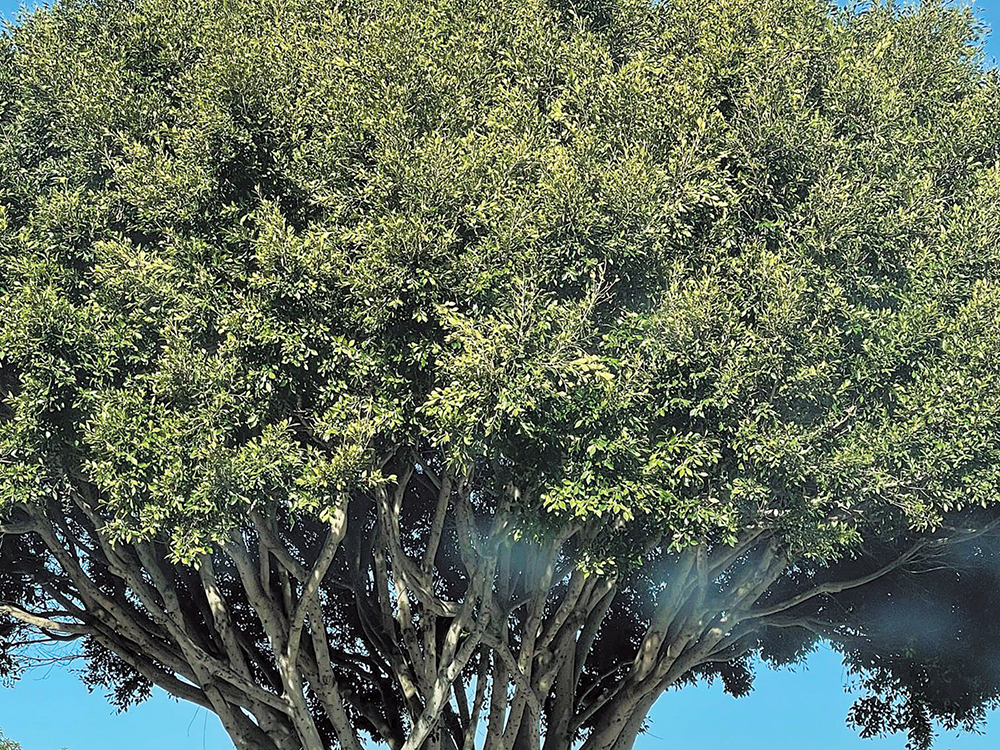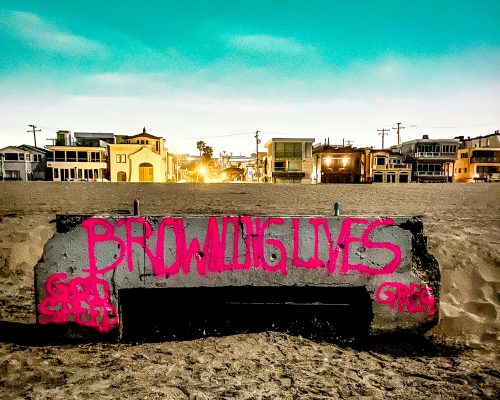by Rachel Reeves
Mara Lang grew up in a Tree City, or a place where the local government has ordinances for protecting trees. Magnolias, planted around the same time as most homes, in the 1920s, shaded the sidewalks of her neighborhood.
Lang, now the vice president of the South Bay Parkland Conservancy, later moved to Ave. H in Redondo Beach, where she had easy access to the city’s treasured beach. Then she moved a little farther north in Redondo Beach. Walking her child around their home, she began to notice empty spots where trees had been.
“As soon as I started to see it, I couldn’t un-see it,” she said. She began campaigning for a tree ordinance in Redondo Beach, which she said would “help create a culture within the city of tree preservation.”
On Sunday afternoon, Lang and her two small children joined about a dozen other residents of Redondo and Torrance, including Mayor Bill Brand and Councilmember Nils Nehrenheim, on the median along Pacific Coast Highway, just east of Palos Verdes Boulevard, to protest the planned removal of Frankie the Ficus.
The protestors held signs: “Trees Over Cars.” “Save Our Tree Canopies.” “Save Trees. Save Humankind.” “Stop cutting down trees.” “Every Tree Counts.” “This tree is habitat.” “Honk for Trees.” “R.I.P. Frankie the Ficus.”
Brand held a megaphone, which he aimed at passing cars. “Save the tree,” he said into a line of traffic. Drivers honked in support.
“I thought we had saved this tree five years ago,” Brand said. Prior to the protest, he had written an email to the City of Torrance, which had applied for a permit from the California Department of Transportation (Caltrans) to remove the tree and the median to create another left-turn lane for traffic turning onto Palos Verdes Boulevard. In his email, Brand recounted two years of public hearings at meetings of the Redondo Beach City Council and Planning Commission, as well as a lawsuit leveled against the city over the size of the proposed development just north of Pacific Coast Highway, several lanes away from Frankie the Ficus.
“Saving this tree became an important component of the settlement,” Brand wrote in his email. He explained that a settlement finalized in August of 2017 reduced the development from 180 units to 115 units, which meant less traffic, which meant the tree would remain. He suggested removing part of the median, about 30 feet of it, rather than the whole thing, in order to improve the flow of traffic.
“On behalf of the residents of Redondo Beach, and even some of the Torrance residents nearby, please reconsider removing this beautiful tree to maintain the aesthetic beauty of this area, as well as the shading, bird habitat, carbon capture and overall natural aspects it provides,” he wrote.
Brand then took to his public Facebook page: “Alert! We just found out last Friday that the City of Torrance plans to remove this beautiful ficus tree this Wednesday!!!”
About a dozen masked protestors showed up on Sunday in the winter sun. They held signs in the shade of the ficus for the passing cars.

Councilmember Nehrenheim, who held a sign that said “Trees for Redondo,” said the protest reflects the city’s efforts to become a Tree City, like Torrance. He said it was also a reminder to a neighboring city to honor its commitment to protecting trees.
“Trees are the character of a community,” Nehrenheim said. “We fought really hard to keep that tree. We don’t believe that traffic mitigation is more important than the character of our community.”
For staff at the City of Torrance, traffic mitigation in that particular area had become important enough to warrant two years of design, engineering, and permit applications.
Elizabeth Overstreet, an engineering manager with the City of Torrance, said the project was conceptualized in response to complaints from residents on side streets just south of Pacific Coast Highway. Whenever traffic on Pacific Coast Highway backed up, drivers would turn left into residential areas in order to avoid waiting for a green light to turn left on Palos Verdes Boulevard.
“People complained, so we put up signs restricting left turns onto Camino de las Colinas, and then people started turning onto other streets, and then those residents were concerned as well, because they already had cut-through traffic but now they were getting more, so the ultimate solution was, okay, there’s just not enough capacity at the intersection of Pacific Coast Highway and Palos Verdes Boulevard for people to make that left-hand turn,” she said. “If we increase that capacity, put in dual left-turn lanes, and change the timing on the signal, then that would eliminate the cut-through traffic into the neighborhood.”
Hearings were convened and residents were notified. In hindsight, Overstreet suggested that perhaps residents didn’t realize that if the median goes, the tree goes also.
“Maybe they envisioned it differently,” she said.
After Sunday’s protest, staff at the City of Torrance agreed to put the project on hold.
“It gives us a little bit more time to discuss it with residents, and explain what’s needed from a design engineering standpoint, and try to balance that with the aesthetics … We’re just taking a step back and regrouping at this point,” she said.
A notice of deferred work was circulated to residents in the area. The matter will be discussed at the April meeting of the Torrance Traffic Commission, to which interested residents are invited.
“Especially in this day and age, where people are slinging mud and being violent, this shows that the peaceful power of the pen and the voice is the mightiest of all,” Nehrenheim said.
Brand took a more measured view.
“All we did was delay it,” he said. Still, he said, Torrance didn’t have to listen, but did.
“They did not have to stop this in its tracks, so we really appreciate them being willing to be open minded and reconsider,” Brand said. “I hope we can return the favor one day. Showing up is everything. Showing up and speaking up is everything. Several Torrance residents showed up numerous times during our hearings, expressing their concerns for that tree. So we’re listening. And they’re listening, too.” ER









